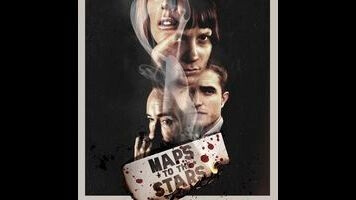For the first time in his half-a-century of filmmaking, David Cronenberg has traveled to Hollywood to make a movie—and not just any movie, mind you, but one that’s actually about Hollywood. Even coming from the director who once instructed James Spader to fuck a leg wound and Jeff Goldblum to peel off his own fingernails, the results are not pretty. Maps To The Stars, Cronenberg’s aggressively broad assault on La La Land, presents a Los Angeles both figuratively and literally inbred, where pill-popping celebrities, foul-mouthed teenage tyrants, and crazed starfuckers splash around in a very shallow gene pool. Yet, an irony, possibly intentional, hangs heavily over the proceedings, like an iconic sign wedged into a hill: For a film obsessed with the closed system of showbiz—an industry that thrives by repeating itself, a culture of remakes and cyclical melodrama—Maps offers almost nothing but recycled insights, regurgitating ancient anti-Hollywood clichés. It’s a movie you’ve seen many times before, just never in the perverse key of Cronenberg.
In truth, the film is a collision of sensibilities, the latest instance of the Canadian auteur merging his own interests, Brundlefly-style, with those of another writer. Unfortunately, in this case said writer is Bruce Wagner, the novelist and screenwriter who’s made a career out of penning witless Tinseltown takedowns. He wrote Maps years and years ago, and it shows: Though references to Sally Draper, Anne Hathaway, and Twitter have been sprinkled throughout, the film could otherwise have been released as early as 1989, when Wagner’s Scenes From The Class Struggle In Beverly Hills came out. For those not shocked by the news that Hollywood runs on anti-depressants and New Age spiritual hooey, the value of this tired screed will come down to the nightmarish manner in which it’s sometimes delivered—the way the film frequently threatens to teeter from low comedy into high horror, desperation bubbling up from the vacuous depths of these phony monsters.
Though the publicity machine has emphasized Maps To The Stars as Cronenberg’s second collaboration with pinup-boy muse Robert Pattinson, the actor has a much smaller role here than he did in Cosmopolis. Climbing from the back of the limousine to the front, Pattinson plays a hired chauffeur—though he really wants to write and act!—and our entryway into the film’s inner circle of toxic somebodies. There’s 13-year-old Benjie (Evan Bird), an adolescent idol fresh out of rehab. One part Justin Bieber, two parts Joffrey Baratheon, he’s the enfant terrible star of a hit franchise called Bad Babysitter—another detail that dates Wagner’s script, as this preteen Porky’s seems more appropriate for a young Corey Haim than today’s class of Disney Channel alums. Benjie’s parents are the self-help guru Stafford (John Cusack) and stage mother Christina (Olivia Williams). They speak a private language of platitudes and name-drops, while their son hurls homophobic, anti-semitic insults. They are the first family of California privilege.
Into the lives of these damaged characters dances Agatha (Mia Wasikowska), an unstable, starry-eyed Florida transport who hides her scarred, burnt skin—and maybe her true motives—behind thick black clothes. (She’s the movie’s agent of chaos, a skeleton emerging from the closet.) Cashing in on a star connection, Agatha scores a job as the personal assistant of Havana Segrand (Julianne Moore), an aging actress desperate to land the lead in a remake of a ’60s melodrama—the role originated by her famous mother, who Havana claims sexually abused her as a child, before she tragically perished in a fire. Moore tears into the part with fearless abandon, dropping trou for messy, loveless sex scenes and a bit of scatological humor. Cronenberg, that one-time master of body horror, must have seen a new source of corporeal anxiety in the fading fortunes of female movie stars, whose “value” the industry links exclusively to their nubile flesh. But any provoked empathy is cancelled out by the uncharitable characterization: Havana is as vapid and callous as everyone else on screen, a careerist so ghoulish that she ecstatically celebrates the death of a rival’s young child.
Such over-the-top black comedy isn’t really Cronenberg’s strong suit, and the director sucks the air out of the film’s sub-Entourage scenes of celebrity allusions and boys and girls behaving badly. He’s more interested in the private shames and secret fears of these easy targets, the madness that gnaws away at their empty ambitions. Maps equates the incestuous nature of Hollywood to actual incest, affording the filmmaker a taboo topic he’s never broached, and scenes of the characters being haunted by literal/figurative ghosts—including Havana’s deceased mother, played by the terrific Sarah Gadon—pulse with a menace Cronenberg hasn’t conjured since his horror heyday. He remains entranced, too, by the sterile lap of luxury, the way modern architecture mirrors the soul sickness of those who occupy it. But Cosmopolis, with its alien rhetoric and doomsday projections, offered cleaner inroads to his preoccupations. Flummoxed by such overcooked material, he seems here to be channeling David Lynch by way of Richard Kelly.
Not surprisingly, the film achieves its greatest power when moving out of the realm of easy star-culture potshots and into the director’s sex-and-violence wheelhouse. Working with his longtime crew, Cronenberg amps up the unease when the fluids start flowing. And when Williams has a sobbing breakdown, in a pod-like bathtub likely designed by Carol Spier and to the ominous ambience of Howard Shore’s music, it’s possible to imagine a deeper plunge into the poisoned waters of fame and fortune. But as satire, Maps To The Stars is as shallow as its characters. The main impression it imparts is that even a master like Cronenberg can’t escape Hollywood’s perpetual spiral of old ideas. And advocating to burn the whole city down is one of its oldest.








































